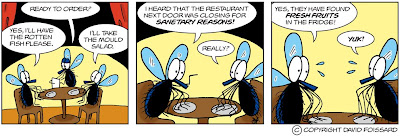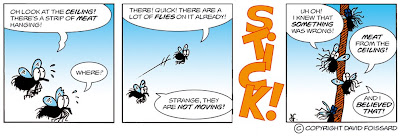
Wednesday, 25 June 2008
Wednesday, 11 June 2008
Joe 20: The end is...not nigh
 Here again, strips 17 to 20 constitute an actual story if they are read one after the other; but what one needs to do with comic strips is to enable the reader to read each strip and understand it even though they might not have read the previous one (which is often the case if the strip is published in a newspaper for instance). To do that, the artist has to resume the previous strip in the first frame of the new strip, or find a way to "re-start" a story from elements of the previous one.
Here again, strips 17 to 20 constitute an actual story if they are read one after the other; but what one needs to do with comic strips is to enable the reader to read each strip and understand it even though they might not have read the previous one (which is often the case if the strip is published in a newspaper for instance). To do that, the artist has to resume the previous strip in the first frame of the new strip, or find a way to "re-start" a story from elements of the previous one.Wednesday, 6 February 2008
Joe the Fly 14: Contamination
 This is where it gets interesting: one can carry on a story from a strip to another. The key is to resume the preceding strip in one frame, so that if a reader has not seen the previous strip, he / she can understand what is going on right away. This is important for instance when strips are published independently in a newspaper. Whoever reads the paper can appreciate the strip without knowing the characters or the stories that have led to that point.
This is where it gets interesting: one can carry on a story from a strip to another. The key is to resume the preceding strip in one frame, so that if a reader has not seen the previous strip, he / she can understand what is going on right away. This is important for instance when strips are published independently in a newspaper. Whoever reads the paper can appreciate the strip without knowing the characters or the stories that have led to that point.Joe the Fly 6: Narrow escape
Why a strip?
 A strip is pretty hard to do because you need to write a story in just 3 or 4 frames. The reader (who probably doesn't know the characters) must understand what is happening, and hopefully even laugh at the end of it. I find this "challenge" very exciting. It also forces you to find hundreds of situations with the same character.
A strip is pretty hard to do because you need to write a story in just 3 or 4 frames. The reader (who probably doesn't know the characters) must understand what is happening, and hopefully even laugh at the end of it. I find this "challenge" very exciting. It also forces you to find hundreds of situations with the same character.Joe the Fly 2: Saturday night
Joe the Fly 1: Introducing Joe
Subscribe to:
Comments (Atom)


























